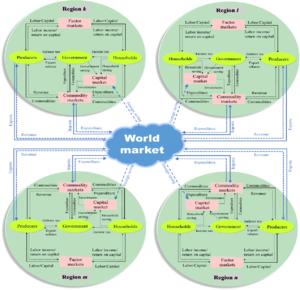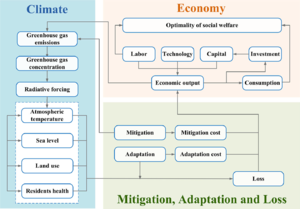Macro-economy - C3IAM: Difference between revisions
(Edited automatically from page C3IAM setup.) |
No edit summary |
||
| Line 3: | Line 3: | ||
|DocumentationCategory=Macro-economy | |DocumentationCategory=Macro-economy | ||
}} | }} | ||
C<sup>3</sup>IAM framework includes three macro-economy modules: the Global Multi-regional Economic Optimum Growth model (C<sup>3</sup>IAM/EcOp), the Global Energy and Environmental Policy Analysis model (C<sup>3</sup>IAM/GEEPA) and the Multi-Regional China Energy and Environmental Policy Analysis model (C<sup>3</sup>IAM/MR.CEEPA). | |||
The C<sup>3</sup>IAM/EcOp is established based on the theory of optimal economic growth and consists of two modules (economic and climate modules) (as shown in Figure 1). The economic module describes the optimal economic growth path and investment decisions under the balance of long-term emission reduction costs and climate losses<ref>Yi-Ming Wei, Rong Han, Ce Wang, Biying Yu, Qiao-Mei Liang, Xiao-Chen Yuan, Junjie Chang, Qingyu Zhao, Hua Liao, Baojun Tang, Jinyue Yan, Lijing Cheng, Zili Yang, 2020. Self-preservation strategy for approaching global warming targets in the post-Paris Agreement era. ''Nature Communications'' 11, 1624.</ref>. | |||
While the climate module, which is a simplified model by upscaling C<sup>3</sup>IAM/Climate, presents the greenhouse gas concentration growth, radiative forcing and temperature change thereafter. The mitigation, adaptation and loss module is simplified based on upscaling C<sup>3</sup>IAM/Loss. To maximize global welfare, the model optimizes regional consumption and investment. Therefore, national optimal mitigation and adaptation decisions could be provided. | |||
[[File:4.png|thumb|Figure 2. The framework of C<sup>3</sup>IAM/GEEPA<ref>Kun Zhang, Qiao-Mei Liang, Li-Jing Liu, Mei-Mei Xue, Bi-Ying Yu, Ce Wang, Rong Han, Yun-Fei Du, Yun-Fei Yao, Jun-Jie Chang, 2020. Impacts of mechanisms to promote participation in climate mitigation: border carbon adjustments versus uniform tariff measures. ''Climate Change Economics'' 11, 2041007.</ref><ref>Li-Jing Liu, Felix Creutzig, Yun-Fei Yao, Yi-Ming Wei, Qiao-Mei Liang, 2020. Environmental and economic impacts of trade barriers: The example of China–US trade friction. ''Resource and Energy Economics'' 59, 101144.</ref>]] | |||
The assumptions, model structure and mathematical formulae between C<sup>3</sup>IAM/GEEPA and C<sup>3</sup>IAM/MR.CEEPA are similar. Both are composed of five basic modules, i.e., production, income, expenditure, investment and foreign trade module. The production module describes the production structure in different regions, in which the input in each sector assumes to follow a nested constant elasticity of substitute (CES) function. The household income mainly comes from labor income and capital returns. We assume that after paying household income tax, households spend disposable income on saving and on the consumption of various goods. Household saving is obtained by multiplying household disposable income with saving rate. The consumption, production and trade of goods and services are fundamentally determined by market prices. Capital and labor allocation is determined by wages and return of capital. The basic frameworks for C<sup>3</sup>IAM/GEEPA and C<sup>3</sup>IAM/MR.CEEPA are shown in Figure 2 and Figure 3, respectively. | |||
[[File:3.png|thumb|Figure 1. The framework of C<sup>3</sup>IAM/EcOp]] | |||
[[File:5.png|thumb|Figure 3. The framework of C<sup>3</sup>IAM/MR.GEEPA<ref>Kun Zhang, Qiao-Mei Liang, Li-Jing Liu, Mei-Mei Xue, Bi-Ying Yu, Ce Wang, Rong Han, Yun-Fei Du, Yun-Fei Yao, Jun-Jie Chang, 2020. Impacts of mechanisms to promote participation in climate mitigation: border carbon adjustments versus uniform tariff measures. ''Climate Change Economics'' 11, 2041007.</ref>]] | |||
Revision as of 15:56, 27 June 2021
| Corresponding documentation | |
|---|---|
| Previous versions | |
| Model information | |
| Model link | |
| Institution | Center for Energy and Environmental Policy Research, Beijing Institute of Technology (CEEP-BIT), China, http://ceep.bit.edu.cn/english/. |
| Solution concept | General equilibrium (closed economy) |
| Solution method | Optimization |
| Anticipation | |
C3IAM framework includes three macro-economy modules: the Global Multi-regional Economic Optimum Growth model (C3IAM/EcOp), the Global Energy and Environmental Policy Analysis model (C3IAM/GEEPA) and the Multi-Regional China Energy and Environmental Policy Analysis model (C3IAM/MR.CEEPA).
The C3IAM/EcOp is established based on the theory of optimal economic growth and consists of two modules (economic and climate modules) (as shown in Figure 1). The economic module describes the optimal economic growth path and investment decisions under the balance of long-term emission reduction costs and climate losses[1].
While the climate module, which is a simplified model by upscaling C3IAM/Climate, presents the greenhouse gas concentration growth, radiative forcing and temperature change thereafter. The mitigation, adaptation and loss module is simplified based on upscaling C3IAM/Loss. To maximize global welfare, the model optimizes regional consumption and investment. Therefore, national optimal mitigation and adaptation decisions could be provided.
The assumptions, model structure and mathematical formulae between C3IAM/GEEPA and C3IAM/MR.CEEPA are similar. Both are composed of five basic modules, i.e., production, income, expenditure, investment and foreign trade module. The production module describes the production structure in different regions, in which the input in each sector assumes to follow a nested constant elasticity of substitute (CES) function. The household income mainly comes from labor income and capital returns. We assume that after paying household income tax, households spend disposable income on saving and on the consumption of various goods. Household saving is obtained by multiplying household disposable income with saving rate. The consumption, production and trade of goods and services are fundamentally determined by market prices. Capital and labor allocation is determined by wages and return of capital. The basic frameworks for C3IAM/GEEPA and C3IAM/MR.CEEPA are shown in Figure 2 and Figure 3, respectively.

- ↑ Yi-Ming Wei, Rong Han, Ce Wang, Biying Yu, Qiao-Mei Liang, Xiao-Chen Yuan, Junjie Chang, Qingyu Zhao, Hua Liao, Baojun Tang, Jinyue Yan, Lijing Cheng, Zili Yang, 2020. Self-preservation strategy for approaching global warming targets in the post-Paris Agreement era. Nature Communications 11, 1624.
- ↑ Kun Zhang, Qiao-Mei Liang, Li-Jing Liu, Mei-Mei Xue, Bi-Ying Yu, Ce Wang, Rong Han, Yun-Fei Du, Yun-Fei Yao, Jun-Jie Chang, 2020. Impacts of mechanisms to promote participation in climate mitigation: border carbon adjustments versus uniform tariff measures. Climate Change Economics 11, 2041007.
- ↑ Li-Jing Liu, Felix Creutzig, Yun-Fei Yao, Yi-Ming Wei, Qiao-Mei Liang, 2020. Environmental and economic impacts of trade barriers: The example of China–US trade friction. Resource and Energy Economics 59, 101144.
- ↑ Kun Zhang, Qiao-Mei Liang, Li-Jing Liu, Mei-Mei Xue, Bi-Ying Yu, Ce Wang, Rong Han, Yun-Fei Du, Yun-Fei Yao, Jun-Jie Chang, 2020. Impacts of mechanisms to promote participation in climate mitigation: border carbon adjustments versus uniform tariff measures. Climate Change Economics 11, 2041007.

